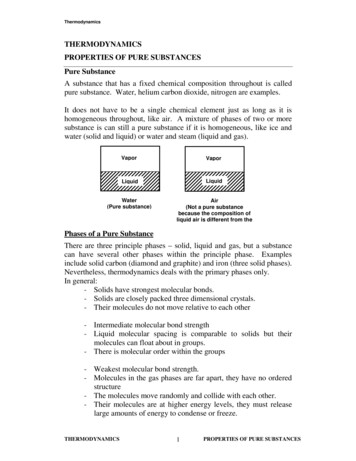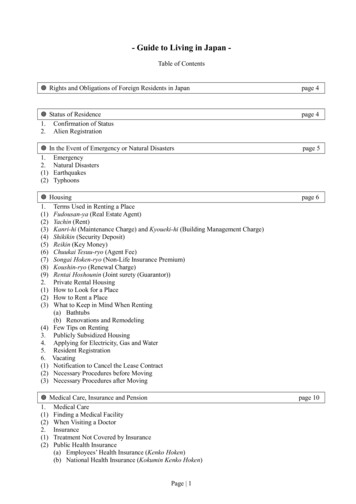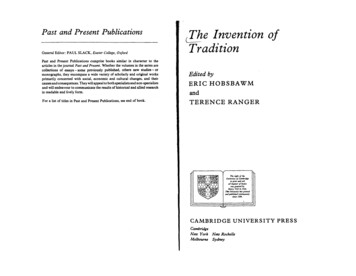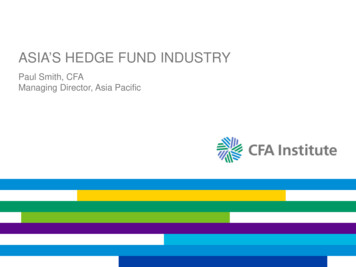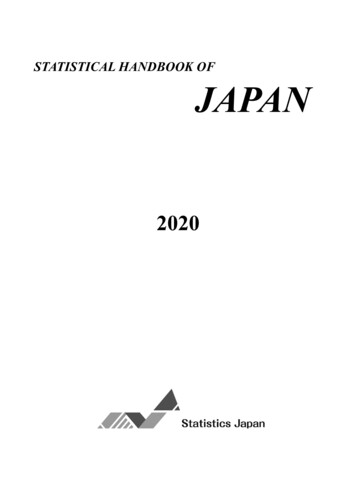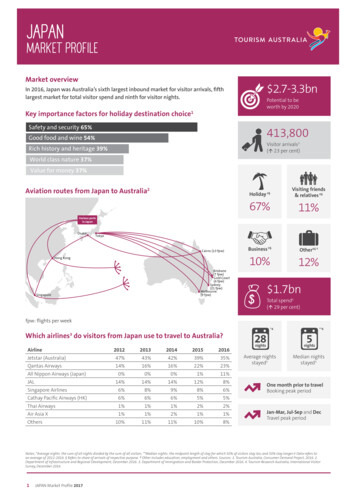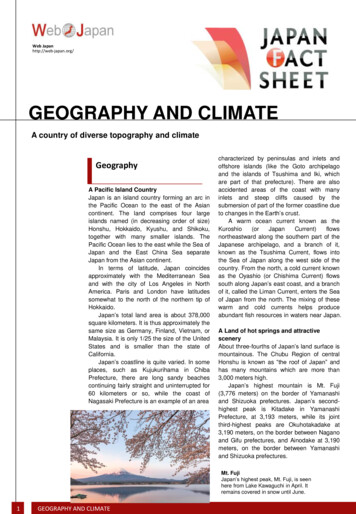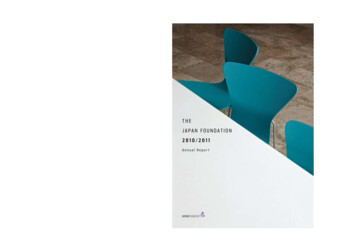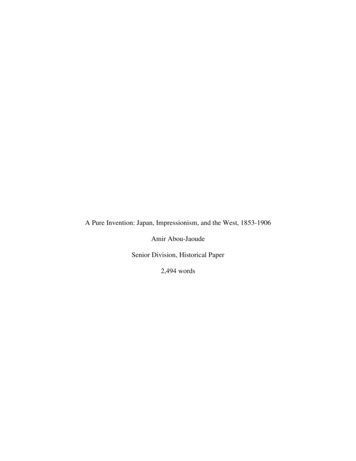
Transcription
A Pure Invention: Japan, Impressionism, and the West, 1853-1906Amir Abou-JaoudeSenior Division, Historical Paper2,494 words
IntroductionThe playwright and poet Oscar Wilde traveled little outside of Europe, yet he feltas if he had journeyed to Japan. In 1891, he wrote that after careful examination of thewoodblock prints of artists like Hiroshige and Hokusai, you could “sit in the park or strolldown Piccadilly, and if you cannot see an absolutely Japanese effect there, you will notsee it anywhere”1—not even, Wilde proclaimed, in Tokyo itself.Forty years earlier, in 1851, Westerners had known little about the floatingkingdom. Since the early 17th-century, Japan had been completely isolated from the West,save for a few Dutch traders who conducted business around Nagasaki. Then, in 1853,the American Commodore Matthew Perry forced Japan to trade with the West underthreat of naval bombardment. Kimonos, fans, and especially woodblock prints by thegreat Japanese artists flooded European markets.These Japanese goods had a particularly profound impact on the arts. Debussywas inspired to write La mer (1905), his most groundbreaking and influential piece, afterseeing Katsushika Hokusai’s print of Under the Wave off Kanagawa.2 The Soviet filmdirector Sergei Eisenstein would turn to Japanese art as he was composing powerfulcinematic images.3 Eventually, the image of the “Great Wave”4 that Debussy admiredwould become a symbol of all things Japan.5The “Japanese effect” was most prominent in art. As Japanese art enteredEuropean salons, French artists were beginning to experiment with Impressionism.1Wilde, p. 38-39.Fulcher, p. 144-145.3 Eisenstein, p. 34.4 See Figure 1 in Appendix A.5 Guth, p. 16-29.21
Painters like Monet, reacting in part to the industrialization of Europe and the rise ofphotography, were interested in capturing how light interacted with a certain objet at agiven moment in time. In Japanese woodblock prints, they found the simplicity and theethereal quality that they strove to create in their art.Critics called this fascination with the Far East “Japonisme.” By the end of the19th-century, there were more woodblock prints in Europe than there were in Japan aswealthy individuals like Frederick Richards Leyland amassed huge collections.6 Yet, asWilde noted, the Japan of Monet, van Gogh, Cezanne, Cassatt, and others only existed inthe woodblock prints of Hiroshige and Hokusai, not in Tokyo. As the Impressionistscreated masterpieces, Japan was industrializing, becoming an imperial power that wouldannex Korea and win territory from China and Russia. The natural idyll of Hokusai andHiroshige was long gone.The encounter between Japan and the West that occurred in 1853 marked thebeginning of a vast artistic exchange between two disparate regions of the world. AsWestern artists were acquainted with and subsequently captivated by the woodblockprints of Hiroshige, Hokusai, and others, their artistic exploration established thefoundation for modern art.Japan and the West Before 1853Even Columbus7 knew of Japan, but unknown to Europeans, the country had beencontrolled by feudal lords (called daimyo) for over five centuries.8 In the late 16thcentury, as the Portuguese began to purchase luxury goods from China and Jesuit6Lambourne, p. 91.Commodore Perry, who would open Japan to the West, was compared to Columbusafter his expedition. See “The Japan Expedition.”8 Hall, p. 137.72
missionaries arrived in the floating kingdom, a daimyo named Oda Nobunaga and hisallies Toyotomi Hideyoshi and Tokugawa Ieyasu sought to unite Japan under one centralgovernment.9The Jesuits, meanwhile, attempted to convert as many Japanese to Christianity aspossible.10 They brought with them detailed maps of the world that featured Europeanstyle illustrations of different peoples. Japanese artists began to copy the art that theJesuits brought with them11, but this encounter between East and West was not to last. In1614, Tokugawa Ieyasu, having defeated the last of the rival daimyo and striving to ridhimself of any threat to his shogunate, passed a series of decrees stating that allWesterners would be driven out of Japan, all Christians in the country would bepersecuted, and Japan would not trade with any foreign power.12 The floating kingdom ofNippon was effectively isolated from the rest of the world.For the next two centuries, while Europeans discovered the wonders of the NewWorld, the marvels of China, and the great civilizations of Africa, Japan would remain amystery. The policy of isolation initiated a “Pax Tokugawa” in Japan.13 Under the stablerule of the shogunate, Japan flourished, and Japanese art developed its own uniquelanguage, free of outside influence.The Floating World9Hane, p. 111.Hane, p. 122.11 Lambourne, p. 13.12 Tokugawa Iemitsu, Sakoku Edict of 1635. The policy began under Tokugawa Ieyasucontinued under the rule of his grandson, Tokugawa Iemitsu. This 1635 decree is themost complete expression of the Tokugawa shogunate policy.13 Hall, p. 161.103
The two major Japanese artists of the Tokugawa period were Utagawa Hiroshige(1797-1858) and Katsushika Hokusai (1760-1849).14 Both began their careersapprenticed to artists who specialized in portraits of Kabuki actors.15 These portraitsattempted to capture the exaggerated expression of the actor, but they also placed aspecial focus on fiction and reality.16 Artists enjoyed contrasting the mask of a Kabukiactor with his more solemn and realistic expression underneath. Both Hiroshige andHokusai painted these portraits early in their career and both spent a considerable amountof time painting Japanese flora and fauna.17Both artists, however, were recognized for their series of woodblock prints,created in the ukiyo-e, or floating world, style. Ukiyo-e prints emphasized the supremacyof nature and the fleeting character of a moment.18 Woodblock prints were surprisinglycheap because an artist could create one image and it could be printed again and again. 19The artist might produce several editions of one print, varying the intensity and the toneof the colors each time. Hiroshige and Hokusai were commissioned by publishers tocreate a series of prints on one theme. Hiroshige’s most famous series is One HundredFamous Views in Edo20, while Hokusai was renowned for his Thirty-Six Views of MountFuji21. In contrast to many of the Impressionists that they would inspire, both Hokusai2214Forrer, Hiroshige, p. 11.Robinson, p. 17-21.16 See Figure 2 in Appendix A.17 Forrer, Hokusai, p. 24-27.18 Robinson, p. 9.19 Smith, p. 36.20 Forrer, Hiroshige, p. 21. Interestingly, Hiroshige also completed a One HundredFamous Views of Mt. Fuji series in response to Hokusai’s work. Hiroshige attackedHokusai because he felt he did not represent the majesty of Mt. Fuji adequately enough.21 Forrer, Hokusai, p. 22. Hokusai also completed a series celebrating the Year of theHorse, the Pacific Ocean, and bridges across Japan.154
and Hiroshige23 were recognized as great artists in their time. Hokusai published tenvolumes of his Manga, collections of drawings designed to instruct aspiring artists how todraw like a master.24 The income he generated from his 3,500 woodblock print designswas considerable—he was able to live a comfortable lifestyle and pay off his grandson’ssizeable gambling debts.25 Unlike many working-class Japanese of his day, Hiroshigetraveled extensively outside of Edo.26Perry’s EncounterAs Hiroshige and Hokusai built their reputations, profound change was occurringin Japan. In the 1830s and 1840s, peasant uprisings and famine rocked Japan, and theshogunate did little to address this instability.27 When four American naval ships arrivedoff the coast of Japan, the Tokugawa shogunate was already crumbling.28The Americans had sent two earlier expeditions to Japan with the purpose ofestablishing relations29, but both the 1832 and 1846 ventures were unsuccessful.30 The1853 expedition was able to open Japan to the West because of the precarious position ofthe shogunate and the personality of its leader, Commodore Matthew Perry.3122Forrer, Hokusai, p. 30-31.Smith, p. 37.24 Hokusai’s Manga included a volume that depicted daily life in Japan, and his focus onordinary activities resonated with the Impressionists. See Duret, p. 28.25 Forrer, Hokusai, p. 3026 Smith, p. 39. Edo was renamed Tokyo during the Meiji Restoration of 1868.27 Hane, p. 198.28 Gordon, p. 46.29 Daniel Webster, then Secretary of State, outlined the reasons for sending Americanships to Japan. See Webster, p. 427-429.30 The 1853 expedition was to be helmed by a Commodore Aulick, but he was replacedwith Commodore Perry due to fear of another failure. See “The Expedition to Japan—Mr. Webster’s Instructions to Commodore Aulick.”31 Morison, p. 264-265.235
Unlike the commanders of the earlier expeditions, Perry did not ask the Japaneseif they wanted to establish trading relations—he forced them to do so.32 He threatened theJapanese with a naval bombardment if they did not open their ports to Americancommerce.33 In his diary, he justified this decision by writing that as the United Stateswas clearly superior to Japan. Therefore, the American “desire to be on terms of amitywith all nations”34 outweighed Japan’s sovereignty. Commodore Perry was hailed as ahero in the West35, and there were even calls for him to run for president.36A Cultural ExchangeAlmost immediately after Commodore Perry arrived in Japan, the artisticexchange between Japan and the West started. One of the most popular woodblock printsof 1854 were portraits of the Americans who had played notable roles in the Perryexpedition.37 While Perry and his lieutenants were depicted wearing the distinctlyWestern regalia of the navy, these portraits were not dissimilar to the portraits of Kabukiactors that had been created for centuries before Perry’s expedition.38 Japanese artists didnot know how to depict the features of the Western “hairy barbarians.”3932Morison, p. 324-325.Perry, p. 90.34 Perry, p. 104.35 See “Testimonial to Commodore Perry.”36 See “The Next Presidency.”37 Morison, p. 305.38 See Figure 3 in Appendix A.39 The Japanese ruling classes used this term to refer to Perry and the Americans duringthe initial exchange of 1853.336
Likewise, Western artists did not know what to make of the Hokusai andHiroshige prints that soon started to appear in Europe.40 Since the Renaissance, all ofWestern art had been grounded in the principles of the Greeks. Even though styles varied,most artists accepted the guidelines for proportion and figure outlined by the classicalsculptors. Most used the perspective and foreshortening techniques first developed by theRomans in their mosaics and then expanded on by early Renaissance artists likeMasaccio.41Japanese art did not make use of perspective and foreshortening. Rather, Japaneselandscapes seemed oddly flat. While post-Renaissance artists paid great attention to theanatomy of their figures42, Japanese artists only suggested the outline of a figure withcursory lines.European artists had seen equally exotic painting from China before, but Japaneseart emerged in the salons at a turning point in art history. Since the Renaissance, artistshad pursued realism in their work. They wanted to make their landscapes and picturesreflections of the real world.43 Then, in the 1830s, photography was invented, and aphotograph could reflect the real world better than any painting could44. As photographyCuriosity and admiration for Japanese culture was not limited to artists. See “The NewYork Crystal Palace—Arrival of the Japanese Contribution” and “The JapaneseEmpire—Predictions of the Country’s Trade and Commerce.”41 Novotny, p. 350-51.42 The Pre-Raphaelite brotherhood also sought to escape the influence of theRenaissance. They painted ethereal, decorative scenes meant to reflect art before theinnovations on the painter Raphael. See Giebelhausen, p. 63.43 Novotny, p. 344.44 Novotny, p. 273.407
became more widespread in an increasingly industrialized world, artists were leftwondering what the purpose of painting was.45Among the first champions of Japanese art were the de Goncourt brothers. Beforecoming into contact with the prints of Hokusai and Hiroshige, the brothers, renowned fortheir hedonistic lifestyles, collected Rococo art46, but upon seeing Japanese art, theywrote that it was “as great an art as Greek art” because “everything [Japanese artists] dois taken from observation.”47Artistic ExplorationAs the de Goncourts built their collection of Japanese art, artists like ClaudeMonet and Camille Pissarro were experimenting with a new, Impressionist style of art.48Impressionism was the art of the moment. On a typical day, Monet would take with himmultiple canvases to a particular site. Then, as the light changed throughout the day,Monet would create paintings of the same subject at different times of day. Monet wouldtake only a few minutes to sketch out a painting, and his rapid working method befittedan increasingly industrial society where trains passed in and out of a station in minutes49and factory machines could produce hundreds of products in an hour.50Japanese art did not inspire Monet to paint the Rouen Cathedral or the haystacksor the water lilies51 again and again, but it did reaffirm his Impressionist convictions.5245Genova, p. 453-460.Lambourne, p. 32.47 De Goncourt, p. 241.48 See “Claude Monet par lui-même.”49 See Figure 4 in Appendix A.50 Novotny, p. 346-48.51 See Figures 5 and 6 in Appendix A.468
Hokusai’s manga gave the Impressionists a rationale for “liberating [themselves] fromconventionally stiff portrayals of human and natural forms.”53For other artists, like Edgar Degas and Mary Cassatt, Japanese art did more thanreinforce their views of painting. Cassatt, renowned for her scenes of mothers andchildren, took particular inspiration from the work of Utamaro, a forerunner of Hokusaiand Hiroshige. Several of her works mirror Utamaro’s prints.54 Like Utamaro, bothCassatt and Degas would paint women bathing55, and all three artists carefully examinedcurved forms and the power of line. Degas’s famous scenes of the theater and the balletwere presaged in the portraits of Kabuki actors and Hokusai’s vibrant prints of publicbaths56.Still, perhaps the great admirer of Japanese art was Vincent van Gogh. Van Goghwould copy Hokusai and Hiroshige’s prints onto a canvas in order to better understandthe way he used line and form.57 In one of his letters to his brother Theo, van Gogh wrotethat even though the French countryside that surrounded him did not resemble any ofHokusai’s prints, looking at the landscapes in a Japanese way will “give you a true ideaof the simplicity of nature here.”58 For van Gogh, Japan was a manifestation of nature,52Napier, p. 41. Although some of his paintings (such as those of the water lilies) wereJapanese-influenced, Monet was already painting the same subject again and again beforehe came into contact with Japanese art.53 Napier, p. 40.54 See Figures 7 and 8 in Appendix A.55 Dumas, p. 64.56 Lambourne, p. 41.57 Lambourne, p. 45-46.58 Van Gogh, p. 363.9
and in painting his own Impressionistic masterpieces, van Gogh would write that “all mywork is in a way founded on Japanese art.”59DisillusionmentAs van Gogh was writing, however, the Japan of the ukiyo-e prints was fading.Perry’s mission had brought strife to the island nation. Rebellious samurai soon toppledthe shogunate, and civil war occurred. At the heart of this conflict was a choice. Japancould either resist Western influence and risk becoming a powerless nation like China, orJapan could emulate the West and have colonies of its own.60Ultimately, Japan chose the latter option. In 1868, the emperor Meiji was declaredthe head of state of Japan.61 Advisors to the emperor quickly established a German-styleparliament and an English-style cabinet.62 After traveling to Europe to see the industrialwonders of the West, Japan began to build factories.63 Even Japanese art began to moveaway from the ukiyo-e style64 and towards the Western Greco-Roman tradition.65 By1910, Japan had defeated Russia and China in territorial wars and had annexed Korea as a59Van Gogh, p. 364.Gordon, p.61-75.61 Although Western newspapers did report that the civil war in Japan was over and theEmperor (or the Mikado) was controlling the country, most did not realize thesignificance of the Meiji Restoration. See “Advices to December 15—Civil War at anEnd—The Mikado and Tycoon—Ship News” and “The Civil War in Japan is NearlyOver.”62 Hall, p. 273-284.63 Gordon, p. 95-96.64 See Figure 9 in Appendix A. This print is by Hiroshige’s grandson, and it clearlydepicts Western clothing and the modern architecture of Japan. It is a sharp contrast fromhis grandfather’s work.65 Duret, p. 20.6010
colony of the Empire of Japan.66 Japanese artists had begun to paint in Western styles,and Western architects were invited to the country to build skyscrapers.While the Japan of the Impressionist era was not the Japan of Hokusai andHiroshige, Japanese art continued to have a profound effect on Western works, even asartists realized in the aftermath of the Russo-Japanese War of 1905 that Japan was not apastoral paradise.67 Just as Hokusai turned to painting Mt. Fuji in the last years of hiscareer, so did Paul Cezanne68. Cezanne’s Mt. Saint-Victoire, painted at multiple anglesand at different times of day, was oddly reminiscent of Hokusai’s series.69The Legacy of JaponismeCezanne died in 1906, and in 1907, a massive retrospective of his work was heldin Paris.70 A young Spanish artist attended that retrospective, and was so moved byCezanne’s mountains that he would later say those paintings “flooded”71 all his work.That artist’s name was Pablo Picasso, and his Cubism would represent the nextstep forward from Impressionism. Cezanne’s mountains were influenced by Hokusai’swork, and so indirectly, Hokusai played a role not only in the Japonisme ofImpressionism, but in the development of modern art.Artists like Monet, van Gogh, and Whistler relished in the exoticism andsimplicity of Japanese art and glorified Japan as a natural paradise. However, OscarWilde was correct. Their Japan was a “pure invention,” and the art of late 18th-century66Hall, p. 301-302.Napier, p. 15.68 Lambourne, p. 50.69 See Figures 10 and 11 in Appendix A.70 See “French Autumn Salon—A Triumphant Success for the Artists Who Exhibit at It.”71 Picasso as quoted in the Art Institute of Chicago curator’s notes on the exhibition“Picasso and Cézanne.” Available at http://www.artic.edu/picasso-and-c-zanne.6711
and early 19th-century Japan did not resemble the industrialized Japan of the late 19thcentury and early 20th-century.The Western encounter with Japanese art was a defining moment in art history,just as the Japanese encounter with the West had enormous repercussions on globalpolitics. The Meiji Restoration and the industrialization that followed made Japan into aworld power and an equal of many European countries. At the same time, modern artmay not have developed in the same way had artists not come into contact with Japan.While these artists were unable to see what Japan was becoming around the turn of the20th-century, they were able to see that art did not have to be confined by the boundariesof Europe. The cultural exchange with Japan launched decades of artistic exploration thatdid not end with the Impressionists or the post-Impressionists. After 1905, the pursuit ofWilde’s “Japanese effect” ended, but artists continued to seek out bold, modern, andabstract ways of seeing the world.12
Appendix AFigure 1: Hokusai, Katsushika. The Great Wave off Kanagawa from Thirty-six Views ofMt. Fuji, c. 1830-33. Color woodblock print. Image courtesy of the Art Institute ofChicago.13
Figure 2: Sharaku, Toshusai. The actor Ichikawa Ebizo IV as Takemura Sadanoshin,1794. Color woodblock print. Image courtesy of the Art Institute of Chicago.14
Figure 3: Japanese print of Commodore Perry completed shortly after the American navyarrived. Image courtesy of the Art Institute of Chicago.15
Figure 4: Monet, Claude. Arrival of the Normandy Train, Gare SaintLazare, 1877.Oil on canvas. Image courtesy of Art Institute of Chicago.16
Figure 5: Monet, Claude. The Japanese Footbridge, 1899. Oil on canvas. Image courtesyof the National Gallery of Art.17
Figure 6: Hiroshige, Utagawa. Precincts of Kameido Tenjin Shrine (Kameido Tenjinkeidai), from the series "One Hundred Famous Views of Edo (Meisho Edo hyakkei)",1856. Color woodblock print. Image courtesy of the Art Institute of Chicago.18
Figure 7: Cassatt, Mary. The Letter, c. 1890-91. Drypoint, softground etching, andaquatint on laid paper. Image courtesy of the National Gallery of Art.19
Figure 8: Utamaro, Kitagawa. Courtesan Hinazuru of the Keizetsu House, c. 1794-95.Color woodblock print. Image courtesy of the Austrian Museum of Applied Arts.20
Figure 9 : Hiroshige, Utagawa III. The Fine Arts Museum and the Shôjô Fountain at theSecond National Industrial Exposition in Ueno Park, 1881. Color woodblock print.Image courtesy of the Museum of Fine Arts, Boston.21
Figure 10: Cézanne, Paul. Mont Sainte-Victoire (La Montaigne Sainte-Victoire), 18921895. Oil on canvas. Image courtesy of the Barnes Foundation, Philadelphia.Figure 11: Hokusai, Katsushika. A Mild Breeze on a Fine Day from Thirty-six Views ofMt. Fuji, c. 1830-33. Color woodblock print. Image courtesy of the Art Institute ofChicago.22
Annotated BibliographyPrimary Sources“Advices to December 15—Civil War at an End—The Mikado and Tycoon—Ship News.” TheEvening Telegraph [Philadelphia, PA] 13 Jan. 1869 first ed.: 1. Print.This newspaper article from 1869 tells of the conclusion of the Japanese civil war. Thenewspaper reports that the Mikado (emperor) is now ruling the country. However, in reality,the Emperor Meiji was little more than a symbol for the Westernizers who had taken powerin Japan. The editors of the newspaper fail to note that the Meiji restoration means thatJapan is moving towards industrialization. Still, the article was useful because it helped meto decipher the terminology the American newspapers of the time used. The Mikado is theemperor, and the Tycoon is the shogun.De Goncourt, Edmund. The Journal of the De Goncourts. London: T. Nelson and Sons, 1910. Print.Edmund and Jules de Goncourt were two brothers who were prominent members of theFrench upper class. They lived a hedonistic lifestyle—both brothers were said to share thesame mistress—and they collected Rococo paintings and erotic prints before they turned theirattention to Japanese art. Hearing the de Goncourts discuss the simplicity of Japanese artreminds one how exotic Japanese art really was when it first appeared in Europe.Eisenstein, Sergei. Film Form: Essays in Film Theory. San Diego: Harcourt Brace Jovanovich,1949. Print.Eisenstein, in my opinion, is the greatest film director in history because of his contributionto our understanding of the medium. Eisenstein studied Kabuki theater and Japanese culturein Moscow shortly after the Russian Revolution, and he explains how the prints of Utamaro,23
Hokusai, and Hiroshige influenced the beautiful and ingenious shots in his films. It wasinteresting to see how the influence of Japanese art was felt beyond Impressionism.“French Autumn Salon—A Triumphant Success for the Artists Who Exhibit at It.” New-York DailyTribune [New York, NY] 13 Oct. 1907: 8, Print.This newspaper article documents the French Autumn Salon of 1907, which included amassive Cezanne retrospective. The article includes a list of all the notable people whoattended. However, they missed perhaps the most important person there. A young PabloPicasso would see Cezanne’s work and be inspired to create Cubism. The legacy ofJaponisme was inherited by Picasso via Cezanne.Monet, Claude. “Claude Monet Par Lui-Même.” Le Temps 26 Nov. 1900: 1. Print.This is a recollection by the Impressionist Claude Monet that was published in a Frenchnewspaper. Interestingly, Monet makes no mention of the Japanese art that played such adefining role in his career. Instead, he talks about the early, heady days of his professionallife, when he was creating the new style of Impressionism along with Pissarro, Renoir, andCaillebotte. I used this memoir primarily in discussing the roots of the Impressionist style.Perry, Matthew C. The Personal Journal of Commodore Matthew C. Perry. Washington D.C.:Smithsonian Institution Press, 1968. Print.The journal of Matthew Perry is fascinating to read because it is a real-time account of theJapan expedition. It documents his thoughts as history was happening. Perry certainlybelieves the Japanese are inferior to the Americans, and he believes he has some kind ofdivine right to force Japan to trade with the West. After 1853, Perry played a small role inJapanese history, but I found this to be a fantastic source when researching the events of1853.24
Selby, Julian A. “The Civil War in Japan is Nearly Over.” The Daily Phoenix [Columbia, SC] 29Nov. 1868: 1. Print.This article is a report of the Meiji Restoration as it happened. Like other contemporarywriters, Selby does not recognize that the Meiji Restoration is a major event and willinfluence Japan’s position in the world and history tremendously. Selby also does notunderstand all the different players and the social, economic, and political forces that led tothe Meiji Restoration. Still, it is fascinating to read about the Meiji Restoration happening inreal time.“Testimonial to Commodore Perry.” Daily American Organ [Washington, D.C.] 22 Nov. 1854: 2.Print.This laudatory article was written by Americans stationed in Canton (a province in thesoutheastern part of China.) It salutes Commodore Perry for his “diplomatic work in Japanand describes him as a man of character, as someone who is fearless, and as someone whoembodies all the principles of America. Today, Commodore Perry is usually seen as asymbol of Western imperialism and overreach, and there is a debate over whether his actionsin Japan were justified. However, there was no debate then, and Commodore Perry was agenuine American hero.“The Expedition to Japan—Mr. Webster’s Instructions to Commodore Aulick.” Cooper’sClarksburg Register [Clarksburg, WV] 05 May 1852: 3. Print.Commodore Aulick was supposed to head the Japan expedition before he was replaced withthe more experienced Commodore Perry. The newspaper actually reprints Webster’s fullletter to Commodore Aulick. This article provided some background on the development ofthe Japan expedition, but it also showed how excited the American populace was to read25
about such a venture. They wanted to read Webster’s whole letter and be a part of thishistory.“The Japan Expedition.” The New York Herald [New York, NY] 23 May 1853 morning ed.: 1.Print.This article was written as Commodore Perry was going to Japan, breaking the Tokugawapolicy of isolation, and opening Japan to the West. The authors predict that CommodorePerry’s expedition will go down in history as one of the greatest and will be rankedalongside Columbus’s voyages and Lewis and Clark’s trek. History has proved themwrong—while many schoolchildren can name Columbus or Lewis and Clark, few know whoCommodore Perry is. Still, I loved reading about the expedition as it was happening. Thisarticle really made me understand that the Japan expedition was not just a diplomaticmission. It was a crucial American achievement in 1853.“The Japanese Empire—Predictions of the Country’s Trade and Commerce.” The New York Herald[New York, NY] 23 Apr. 1852 morning ed.: 2. Print.In 1852, the Japan expedition had not yet taken place, but there was still great interest inJapan. This full-page article speculates on what goods Japan might have to offer. Theauthors also believed that since the United States had opened Japan to the West, they wouldhave a trading advantage. The Japanese would be so grateful to be in contact with the Westthat they would give the U.S. everything valuable that they had. This did not occur. Japanbecame an industrial power. If one told the authors that in less than a century we would fighta long war against Japan, they would not believe it. The authors, like the Impressionists,only saw Japan as an exotic locale.“The Next Presidency.” The American Patriot [Clinton, LA] 27 Dec. 1854: 3. Print.26
This article encourages Commodore Matthew Perry to run for president in 1856.Commodore Perry was a hero to the Americans of 1854, and he was compared with thegreat explorers of the past. Today, he is mostly forgotten and is not remembered as one ofAmerica’s great leaders, but some believed that he could be the man to unite the country andsolve its problems even as the nation was coming apart over the issue of slavery.“The New York Crystal Palace—Arrival of the Japanese Contribution.” The New York Herald[New York, NY] 12 Jul. 1853 morning ed.: 1. Print.This is a meticulous documentation of all the Japanese items sent to New York for theCrystal Palace exhibition. Commodore Perry was in Japan when this was published, and it isfascinating to see how carefully each of the items was described. It was not only artists thatwere enthralled by Japan, but the general public as well.Tokugawa, Iemitsu. “The Closed Country Edict of 1635.” Wake Forest University, n.d. Web. 28February 2016.The policy of Japanese isolation was begun by Tokugawa Ieyasu was continued by hisgrandson, Iemitsu. The closed country edict lays out very strict guidelines for foreign shipsin Japan and is the most complete and thorough decree regarding the policy of isolation. Ihad hoped to use Ieyasu’s original decree, but this edict is the decree that is mostrepresentative of the isolationist policy.Van Gogh, Vincent. Dear Theo: The Autobiography of Vincent van Gogh. New York: Signet, 1969.Print.Van Gogh wrote a plethora of letters to his
volumes of his Manga, collections of drawings designed to instruct aspiring artists how to draw like a master.24 The income he generated from his 3,500 woodblock print designs was considerable—he was able to live a comfortable lifestyle and pay off his grandson's sizeable gambling debts.25 Unlike many working-class Japanese of his day .
